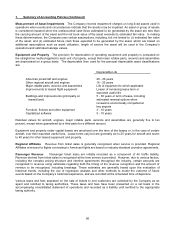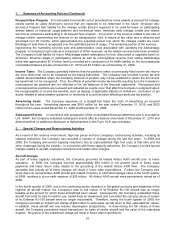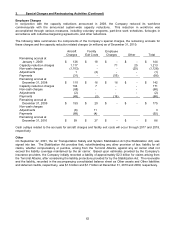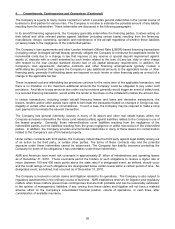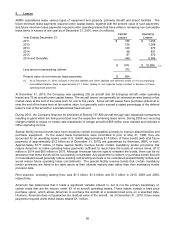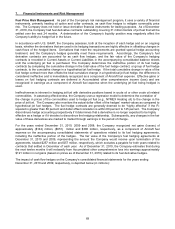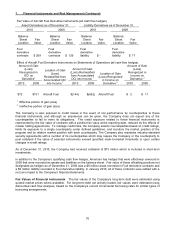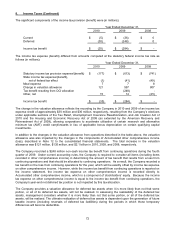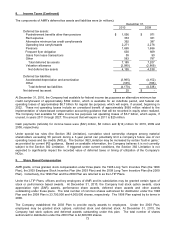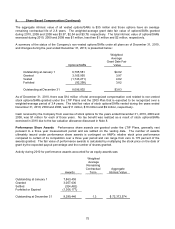American Airlines 2010 Annual Report Download - page 68
Download and view the complete annual report
Please find page 68 of the 2010 American Airlines annual report below. You can navigate through the pages in the report by either clicking on the pages listed below, or by using the keyword search tool below to find specific information within the annual report.
65
4. Commitments, Contingencies and Guarantees (Continued)
The Company is a party to many routine contracts in which it provides general indemnities in the normal course of
business to third parties for various risks. The Company is not able to estimate the potential amount of any liability
resulting from the indemnities. These indemnities are discussed in the following paragraphs.
In its aircraft financing agreements, the Company generally indemnifies the financing parties, trustees acting on
their behalf and other relevant parties against liabilities (including certain taxes) resulting from the financing,
manufacture, design, ownership, operation and maintenance of the aircraft regardless of whether these liabilities
(or taxes) relate to the negligence of the indemnified parties.
The Company’s loan agreements and other London Interbank Offered Rate (LIBOR)-based financing transactions
(including certain leveraged aircraft leases) generally obligate the Company to reimburse the applicable lender for
incremental costs due to a change in law that imposes (i) any reserve or special deposit requirement against
assets of, deposits with or credit extended by such lender related to the loan, (ii) any tax, duty or other charge
with respect to the loan (except standard income tax) or (iii) capital adequacy requirements. In addition, the
Company’s loan agreements, derivative contracts and other financing arrangements typically contain a
withholding tax provision that requires the Company to pay additional amounts to the applicable lender or other
financing party, generally if withholding taxes are imposed on such lender or other financing party as a result of a
change in the applicable tax law.
These increased cost and withholding tax provisions continue for the entire term of the applicable transaction, and
there is no limitation on the maximum additional amounts the Company could be obligated to pay under such
provisions. Any failure to pay amounts due under such provisions generally would trigger an event of default and,
in a secured financing transaction, would entitle the lender to foreclose on the collateral to realize the amount due.
In certain transactions, including certain aircraft financing leases and loans and derivative transactions, the
lessors, lenders and/or other parties have rights to terminate the transaction based on changes in foreign tax law,
illegality or certain other events or circumstances. In such a case, the Company may be required to make a lump
sum payment to terminate the relevant transaction.
The Company has general indemnity clauses in many of its airport and other real estate leases where the
Company as lessee indemnifies the lessor (and related parties) against liabilities related to the Company’s use of
the leased property. Generally, these indemnifications cover liabilities resulting from the negligence of the
indemnified parties, but not liabilities resulting from the gross negligence or willful misconduct of the indemnified
parties. In addition, the Company provides environmental indemnities in many of these leases for contamination
related to the Company’s use of the leased property.
Under certain contracts with third parties, the Company indemnifies the third party against legal liability arising out
of an action by the third party, or certain other parties. The terms of these contracts vary and the potential
exposure under these indemnities cannot be determined. The Company has liability insurance protecting the
Company for some of the obligations it has undertaken under these indemnities.
AMR and American have event risk covenants in approximately $1 billion of indebtedness and operating leases
as of December 31, 2010. These covenants permit the holders of such obligations to receive a higher rate of
return (between 100 and 600 basis points above the state rate) if a designated event, as defined, should occur
and the credit ratings of such obligations are downgraded below certain levels within a certain period of time. No
designated event, as defined, had occurred as of December 31, 2010.
The Company is involved in certain claims and litigation related to its operations. The Company is also subject to
regulatory assessments in the ordinary course of business. AMR establishes reserves for litigation and regulatory
matters when those matters present loss contingencies that are both probable and can be reasonably estimated.
In the opinion of management, liabilities, if any, arising from these claims and litigation will not have a material
adverse effect on the Company’s consolidated financial position, results of operations, or cash flows, after
consideration of available insurance.







